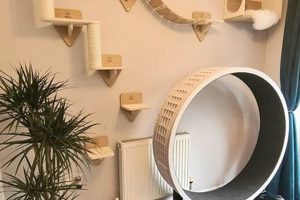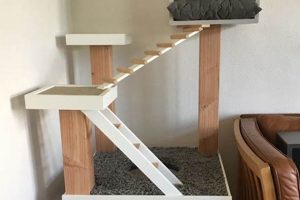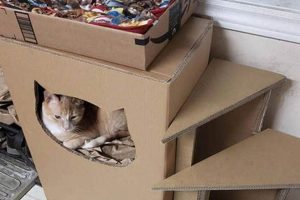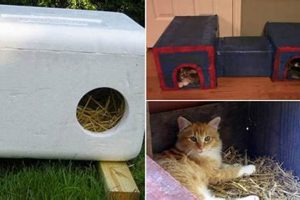The creation of customized outdoor housing for felines, often involving repurposed materials and basic construction techniques, allows individuals to provide refuge for stray or feral animals. Examples range from insulated containers made from plastic bins to more elaborate wooden structures designed for weather protection.
Constructing these shelters offers several advantages, including promoting animal welfare by mitigating the risks associated with exposure to harsh weather conditions. This practice also contributes to responsible community care by addressing the needs of unowned animal populations. Historically, providing shelter to domestic animals has been a common practice, evolving from simple lean-tos to more sophisticated, purpose-built designs.
The following sections will explore various design considerations, material options, and construction methods for effectively building these essential structures.
Essential Guidance for Feline Shelter Construction
The following guidelines aim to enhance the effectiveness and longevity of outdoor feline shelters, ensuring the safety and comfort of their intended occupants.
Tip 1: Insulate Thoroughly: Insulation is paramount for temperature regulation. Straw, not hay, provides optimal insulation without absorbing moisture. Avoid blankets or towels, as they can become damp and promote bacterial growth.
Tip 2: Choose Weather-Resistant Materials: Opt for durable, waterproof materials such as plastic storage bins or treated wood. These materials resist degradation from rain, snow, and extreme temperatures.
Tip 3: Elevate the Structure: Raising the shelter a few inches off the ground prevents water from entering and protects against ground-level cold. Bricks or wooden blocks can serve as effective supports.
Tip 4: Provide a Discreet Entrance: A small entrance, ideally angled or baffled, minimizes exposure to wind and predators. Aim for an opening just large enough for a cat to enter comfortably.
Tip 5: Camouflage the Exterior: Blending the shelter with its surroundings discourages human interference and provides a sense of security for the cats. Natural colors and strategic placement are beneficial.
Tip 6: Implement a Maintenance Schedule: Regular cleaning and inspection are essential. Replace soiled bedding and repair any damage promptly to maintain a hygienic and secure environment.
Tip 7: Consider Multiple Shelters: In areas with multiple cats, providing several shelters reduces competition and allows for individual space, promoting a more stable community dynamic.
Adhering to these guidelines will significantly enhance the comfort and safety provided by outdoor feline shelters. Prioritizing insulation, weather resistance, and strategic placement ensures a secure and welcoming environment for vulnerable animals.
The subsequent section will address common challenges encountered during construction and offer solutions for optimal shelter design and placement.
1. Material Selection
Material selection is a foundational element of effective feline shelter construction. The longevity, insulation properties, and overall suitability of a shelter are directly determined by the materials employed. Inadequate choices lead to rapid deterioration, reduced thermal protection, and potential harm to the animals using the structure. For example, untreated wood exposed to persistent moisture degrades rapidly, fostering mold growth and structural instability, thus rendering the shelter unusable. Conversely, durable, weather-resistant materials, such as polyethylene plastic or pressure-treated lumber, provide a robust barrier against environmental stressors, extending the shelter’s lifespan and minimizing the need for frequent repairs. The cause-and-effect relationship between material choice and shelter performance is undeniable: proper material selection leads to a durable, functional shelter, while poor material selection results in a short-lived and potentially harmful structure.
Practical applications demonstrate the significance of this principle. Shelters constructed from repurposed plastic storage bins, when properly insulated, provide excellent protection from rain and wind at a low cost. Similarly, using pressure-treated plywood, designed for outdoor use, ensures a durable framework that can withstand seasonal temperature fluctuations and precipitation. Consider the difference between a shelter built from cardboard, which quickly disintegrates in wet conditions, and one constructed from a recycled plastic barrel, which offers years of reliable service. The choice of materials is not merely aesthetic; it is a functional imperative directly impacting the shelter’s effectiveness.
In summary, material selection represents a critical determinant of feline shelter success. By prioritizing durable, weather-resistant, and non-toxic materials, builders ensure the long-term viability of their shelters and contribute to the well-being of the animals they are intended to protect. The challenge lies in balancing cost-effectiveness with durability, often requiring resourceful use of recycled materials and careful consideration of local climate conditions. Ultimately, the selection of appropriate materials represents a fundamental step in responsible and effective shelter construction.
2. Insulation Efficiency
Insulation efficiency is paramount in feline shelter construction, directly affecting the internal temperature and habitability of these structures, particularly during periods of extreme weather. Proper insulation mitigates temperature fluctuations, providing a stable and comfortable environment for the animals. Its impact extends beyond mere comfort, influencing the survival rates of vulnerable populations.
- Material Thermal Resistance (R-value)
The R-value of a material quantifies its resistance to heat flow. Higher R-values indicate greater insulation effectiveness. In feline shelters, utilizing materials with substantial R-values, such as rigid foam insulation or densely packed straw, minimizes heat loss during winter and prevents overheating in summer. For instance, a shelter lined with R-5 insulation retains heat significantly better than one with only a thin layer of fabric, reducing the cat’s metabolic demand for maintaining body temperature.
- Air Infiltration Minimization
Air leaks compromise insulation efficiency. Even with high-R-value materials, gaps and cracks allow for significant heat exchange with the external environment. Effective shelter design incorporates strategies to minimize air infiltration, such as sealed seams, overlapping panels, and a small, baffled entrance. Consider a shelter with unsealed joints compared to one with carefully caulked seams; the former loses heat much faster, rendering the insulation less effective.
- Moisture Management
Moisture reduces the effectiveness of most insulation materials. Wet insulation conducts heat more readily than dry insulation, negating its thermal resistance. Therefore, moisture management is crucial. Using water-resistant insulation materials like closed-cell foam and ensuring proper ventilation to prevent condensation are essential. For example, straw bedding, if not protected from rain, becomes damp and loses its insulating properties, whereas a waterproof shelter exterior prevents this degradation.
- Shelter Size and Volume
The internal volume of a shelter influences the effort required to maintain a stable temperature. Smaller shelters require less energy to heat or cool, making insulation more effective. Designing a shelter that is appropriately sized for one or two cats optimizes insulation efficiency. A large, sparsely occupied shelter loses heat more quickly, requiring more insulation to achieve the same level of warmth as a smaller, well-insulated structure.
These facets of insulation efficiency are integral to the success of any “cat shelter diy” project. Effective insulation strategies not only enhance the comfort and safety of the shelter but also reduce the energetic demands on the animals, increasing their chances of survival in harsh conditions. Prioritizing thermal resistance, minimizing air infiltration, managing moisture, and optimizing shelter size are all essential elements in creating a truly effective outdoor refuge.
3. Weatherproofing
Weatherproofing is a critical consideration in the successful construction of outdoor feline shelters. It involves implementing design features and selecting materials that protect the shelter’s interior from rain, snow, wind, and extreme temperatures, ensuring a safe and habitable environment for feline occupants. Failure to adequately weatherproof a shelter leads to moisture penetration, temperature fluctuations, and accelerated deterioration of the structure, potentially harming the animals it is intended to protect.
- Roof Design and Overhang
The roof design plays a pivotal role in diverting water away from the shelter’s entrance and walls. An overhanging roof extends beyond the walls, preventing rainwater from running directly down the sides and seeping into the structure. A sloped roof facilitates water runoff, preventing pooling and reducing the risk of leaks. For instance, a flat roof without an overhang accumulates water, which eventually finds its way into the shelter, while a pitched roof with adequate overhangs effectively channels water away, keeping the interior dry.
- Sealing and Seam Treatment
Gaps and seams in the shelter’s construction represent potential entry points for water and wind. Properly sealing these areas with weatherproof caulking or sealant creates a barrier against the elements. Overlapping construction materials, such as overlapping roof panels or siding, further reduces the risk of water penetration. A shelter with exposed seams is vulnerable to leaks, whereas a shelter with sealed and overlapping joints provides a more robust defense against weather.
- Waterproof Materials and Coatings
Selecting materials inherently resistant to water damage or applying waterproof coatings is essential. Pressure-treated lumber, polyethylene plastic, and galvanized steel are examples of materials that withstand prolonged exposure to moisture. Waterproofing paints, sealants, and membranes add an extra layer of protection to vulnerable surfaces. A shelter built from untreated wood rots quickly in wet conditions, while a shelter constructed from waterproof materials or coated with a waterproof sealant remains durable and dry.
- Elevation and Drainage
Elevating the shelter off the ground prevents water from entering through the base and allows for better drainage around the structure. Placing the shelter on bricks, wooden blocks, or a raised platform elevates it above ground-level moisture. Ensuring proper drainage around the shelter directs water away from the foundation, reducing the risk of flooding. A shelter sitting directly on the ground is prone to water damage, while an elevated shelter with good drainage remains dry and protected.
In essence, weatherproofing constitutes a critical aspect of responsible “cat shelter diy.” By integrating these design features and material choices, builders can create shelters that provide effective protection from the elements, ensuring the well-being and survival of the animals they are intended to serve. Neglecting weatherproofing considerations renders a shelter ineffective, negating the purpose of its construction.
4. Structural Integrity
Structural integrity is a paramount concern in the design and construction of outdoor feline shelters. The ability of a shelter to withstand environmental stresses, resist damage, and maintain its form directly influences its effectiveness in providing safe and secure refuge for its occupants.
- Foundation Stability
The foundation is the bedrock upon which the entire structure rests. A stable foundation prevents settling, tilting, and eventual collapse of the shelter. Materials used for the foundation, such as concrete blocks or pressure-treated wood, must be resistant to moisture and ground movement. Consider a shelter placed directly on soil, which is prone to erosion and subsidence, compared to one supported by a level concrete base, which provides a stable and enduring platform.
- Frame Robustness
The frame provides the skeletal support for the shelter, bearing the weight of the roof, walls, and any accumulated snow or debris. Strong framing materials, such as treated lumber or metal studs, are essential for resisting bending, warping, and breakage under load. A poorly constructed frame, with inadequate bracing or weak connections, risks collapse under stress, rendering the shelter unusable. A shelter with flimsy, untreated wooden supports is susceptible to rot and structural failure, unlike one with a reinforced, weatherproofed frame.
- Joint and Fastener Security
The connections between structural elements are critical points of potential failure. Joints must be securely fastened with appropriate hardware, such as screws, bolts, or nails, to prevent loosening or separation under stress. Adhesive bonding can further enhance joint strength. A shelter with loosely fitted or corroded fasteners is prone to instability and eventual disintegration, while a shelter with properly secured connections maintains its structural integrity over time.
- Material Durability and Resistance to Degradation
The inherent durability of the materials used in construction directly impacts the shelter’s long-term structural integrity. Materials must be resistant to rot, insect infestation, UV degradation, and other forms of environmental wear. Untreated wood, for example, is highly susceptible to decay, while pressure-treated lumber and certain plastics offer superior resistance. A shelter constructed from biodegradable materials has a limited lifespan, while a shelter built with durable, weather-resistant materials retains its structural integrity for many years.
These facets, when properly addressed, ensure that a “cat shelter diy” project results in a durable and reliable structure. The stability of the foundation, the robustness of the frame, the security of the joints, and the durability of the materials collectively determine the shelter’s ability to withstand the elements and provide lasting protection for its feline occupants.
5. Strategic Placement
Strategic placement significantly influences the effectiveness of any “cat shelter diy” project. Shelter positioning dictates exposure to environmental factors, predator vulnerability, and feline comfort. Poorly considered placement negates the benefits of a well-constructed shelter. For instance, a structurally sound, insulated shelter placed in a high-traffic area experiences increased stress from human interaction and may deter feline occupancy, rendering its physical attributes irrelevant. Conversely, a shelter strategically located in a sheltered, secluded area offers optimal protection and encourages consistent use. The cause-and-effect relationship between strategic placement and shelter utility is direct and demonstrably impactful.
Real-world examples illustrate the practical significance of strategic placement. Shelters positioned facing prevailing winds experience increased heat loss and moisture penetration, compromising their internal environment. Locating shelters near food sources attracts unwanted attention from other animals, potentially jeopardizing feline safety. Effective placement involves considering microclimates within a specific area, identifying natural windbreaks, and selecting locations that minimize human disturbance. A shelter tucked under an evergreen shrub receives natural insulation and concealment, while one placed in direct sunlight experiences extreme temperature fluctuations, potentially harming the occupants. Furthermore, proximity to escape routes and elevated vantage points enhances feline security and reduces stress.
Ultimately, strategic placement is an indispensable component of successful “cat shelter diy.” Prioritizing shelter location based on environmental factors, predator avoidance, and feline behavioral needs optimizes its functionality and maximizes its positive impact on the animals it serves. While structural integrity and insulation are critical, a shelter’s potential remains unrealized without careful consideration of its surroundings. Challenges include balancing accessibility with security and adapting to varying environmental conditions. Strategic placement transforms a mere structure into a haven, increasing its value and contributing to responsible community animal care.
Frequently Asked Questions Regarding Feline Shelter Construction
This section addresses common inquiries concerning the design, construction, and deployment of outdoor feline shelters. These questions aim to clarify best practices and mitigate potential challenges associated with providing refuge for vulnerable animals.
Question 1: What are the most effective materials for insulating a feline shelter?
Straw, as opposed to hay, provides superior insulation due to its lower moisture retention. Rigid foam insulation and closed-cell foam are also viable options. Avoid blankets or towels, as these absorb moisture and promote bacterial growth.
Question 2: How can a shelter be effectively protected from the elements?
Implementing an overhanging roof, sealing seams with weatherproof caulk, and utilizing waterproof materials are essential weatherproofing measures. Elevating the shelter off the ground further mitigates moisture exposure.
Question 3: What constitutes an appropriate entrance size for a feline shelter?
The entrance should be just large enough for a cat to comfortably enter and exit, typically around six to eight inches in diameter. Smaller entrances minimize exposure to wind and predators.
Question 4: How should a shelter be positioned to maximize its effectiveness?
Strategic placement involves selecting a location sheltered from prevailing winds, away from high-traffic areas, and preferably under natural cover, such as shrubs or trees. Consider proximity to escape routes and elevated vantage points for the animals.
Question 5: What maintenance is required for an outdoor feline shelter?
Regular cleaning to remove soiled bedding and debris is necessary. Inspect the shelter periodically for damage and promptly repair any breaches to maintain its structural integrity and weather resistance.
Question 6: Is it necessary to provide multiple shelters in areas with numerous cats?
Providing multiple shelters reduces competition among cats and allows for individual space, promoting a more stable social dynamic within the community. This is particularly important during harsh weather conditions.
These FAQs provide a concise overview of crucial considerations for building and maintaining effective outdoor feline shelters. Prioritizing insulation, weatherproofing, strategic placement, and regular maintenance is essential for ensuring the safety and well-being of the animals.
The subsequent section will explore community engagement strategies related to feline shelter initiatives.
Concluding Remarks on Feline Shelter Provision
This exploration of “cat shelter diy” has highlighted essential aspects of constructing effective outdoor housing for felines. Key considerations include material selection, insulation efficiency, weatherproofing techniques, structural integrity, and strategic placement. The effective integration of these elements directly contributes to the creation of safe, warm, and durable shelters, capable of withstanding environmental stressors and providing refuge for vulnerable animals.
The commitment to constructing and maintaining such shelters represents a tangible investment in community animal welfare. While the task presents challenges, the resulting benefits for feline populations are undeniable. Continued dedication to improving shelter designs and expanding their availability will significantly enhance the well-being of unowned and feral cats, fostering a more compassionate and responsible approach to animal care.







